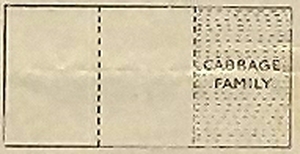 On most soils, 42 lb. (19Kg) of National Growmore Fertilizer should be enough for a 10-rod plot (300 square yards) (253 square metres). A few days before sowing or planting, scatter 1 lb. (454g) evenly over every 10 sq. yards (8.4 square metres) and rake in. To give this general dressing to a 10-rod allotment will take 30 lb. (13.6Kg) This will leave 12 lb. (5.4Kg) for giving an extra dressing to potatoes, winter green crops and spring cabbages.
On most soils, 42 lb. (19Kg) of National Growmore Fertilizer should be enough for a 10-rod plot (300 square yards) (253 square metres). A few days before sowing or planting, scatter 1 lb. (454g) evenly over every 10 sq. yards (8.4 square metres) and rake in. To give this general dressing to a 10-rod allotment will take 30 lb. (13.6Kg) This will leave 12 lb. (5.4Kg) for giving an extra dressing to potatoes, winter green crops and spring cabbages.
4-1/2 lb. (2Kg) should be reserved for potatoes and should be applied at planting time. 5-1/2 lb. (2.5Kg) should be kept for applying during August to the autumn and winter green crops when they are making active growth. The remaining 2 lb. (900g) should be used during March as a top dressing for spring cabbage.
This is well thought out fertilisation plan for the average plot. It balances the use of a valuable raw material, fertiliser, with the likely need assuming that farmyard manure is difficult to obtain and average compost production. The initial base dose of 1lb. per 10 square yards or 1.6oz per square yard isn’t a heavy amount but enough to ensure all crops have at least the nutrients to sustain them on poor land.
The balance of the fertiliser is used tactically to supply the plants with the greatest nutrient requirements at the time of year when needed
You will be able to get National Growmore Fertilizer from most sundries merchants. Allotment societies and similar bodies, which have hitherto bought their fertilizers in bulk, are able to buy National Growmore Fertilizer in bulk at reduced prices.
On some allotments or in some gardens it may be necessary to give an additional top dressing of a nitrogenous fertilizer (such as Sulphate of Ammonia) to any growing crops, applying it at the rate of about 1 lb. (454g) per 10 square yards (8.4 square metres).
The importance of LIME
Lime is of great importance to the garden. Decaying vegetable matter and certain fertilizers tend to make soils acid or “sour”. This is bad for plant growth, so lime must be added to make the soil sweet. Do not add too much, for plants grow best in a neutral soil. Lime contains calcium and this is a plant food. Lime or chalk also improves the texture of clay soils, making it easier to get good tilth.
Whilst it is true that calcium is a plant food, the real benefit of lime is in correcting acidity. If soils becomes too acid many vegetables are unable to absorb nutrients from the soil and so starve.
With acid clay soils, liming encourages the fine particles to clump together and form larger particles as in a sandy soil. This is technically called flocculation.
There’s more information on lime including how to measure acidity, how much lime to use to correct this and the various types of lime available on my allotment web site below.
 So do not neglect to lime your land if it needs it ; but do not overdo it. As a general rule the vegetable garden benefits from a dressing of lime every third or fourth year.
So do not neglect to lime your land if it needs it ; but do not overdo it. As a general rule the vegetable garden benefits from a dressing of lime every third or fourth year.
Lime is particularly good for crops of the cabbage family and helps to control “club root”. So lime the part of the plot on which these crops are to be grown. In fact, it is a good plan to lime a third of the plot each year, so that the whole plot will be limed once in three years.
Apply the lime after you have finished digging. Do not apply it at the same time as farmyard manure. Fork it in lightly or let it lie on the surface to be washed in by rain.
If you are uncertain whether or not your soil needs lime, ask some knowledgeable person to advise you – your local Parks Superintendent or the county Horticultural Officer at the County Council Offices in your county town.
Gardening societies, which bulk their orders so that they amount to not less than 2 tons, can get lime for food production at half-price under the Government’s Land Fertility Scheme, if the society is registered as an approved association under the scheme. You can get particulars from the Agricultural Lime Department (U.K.) of the Ministry at Hotel Majestic, St. Annes, Lytham St. Annes, Lancs.


